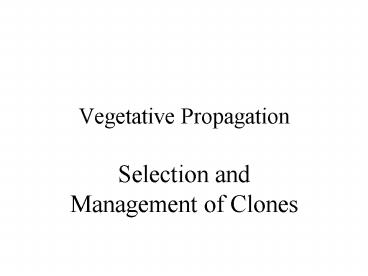Vegetative Propagation - PowerPoint PPT Presentation
1 / 24
Title:
Vegetative Propagation
Description:
shorten time to flower. combine more than one genotype into a single plant ... Time to Flower. Vegetatively propagated plants come into flower at an earlier ... – PowerPoint PPT presentation
Number of Views:1876
Avg rating:3.0/5.0
Title: Vegetative Propagation
1
Vegetative Propagation
- Selection and Management of Clones
2
Reasons for Using Clonal Cv.s
- Fixing superior genotypes
- uniformity of populations
- facilitate/ease of propagation
- shorten time to flower
- combine more than one genotype into a single
plant - control phases of development
3
Fixing Genotypes
- Presently selected clones are heterozygous
- If propagated by seed, may lose characteristics
- Examples
- citrus
- fig
- grapes
- persimmons
4
Uniformity of Populations
- Uniformity-major advantage
- Characteristics
- plant size
- growth rate
- time of flowering
- economic variables on production
5
Facilitate Propagation
- Implies consistent and economically feasible
production when possible. - Examples
- hardwood cuttings of Pomegranate
- cuttings of Raphiolepis or Pittosporum
6
Shorten Time to Flower
- Vegetatively propagated plants come into flower
at an earlier age compared to those propagated by
seed. - Dependent on the maturation of plant tissue.
7
Combine more than One Genotype into one plant
- Use of grafting or budding
- rootstock
- interstock
- Placement of multiple cultivars on one plant
8
Control Phases of Development
- Phases
- juvenile
- transitional
- mature
- Vegetative propagation used to maintain, enhance
of reverse specific phases.
9
Origin of Clonal Cultivars
- Seedling selection
- Mutation
- point mutations
- deletions, duplications and transformations
- bud-sports or bud mutations
- Biotechnology
- recombinant DNA technology
10
Kinds of Genetic Variation within Clones
- Chimeras
- Transposons
- Somaclones
11
Chimeras
- Mutations producing an island of mutant cells
within a growing point of a stem. - Forms a mixture of two genotypes.
- Various kinds of variegation
- Bud sports
- Artificially induced
12
Types of Chimeras
- Periclinal
- Mericlinal
- Sectorial
13
Periclinal
- Mutated tissue completely surrounds an inner core
of non mutated tissue. - Red pigment in apples on outside, inner tissue
have alleles for green and yellow. - Thornless blackberry
- Stable chimera
- Not stable if cuttings used produce shoots from
non mutated tissue.
14
(No Transcript)
15
Mericlinal
- Cells carrying the mutant gene occupy only a part
of the outer cell layer. - Unstable-may revert to non-mutated form,
periclinal chimera or remain a mericlinal
chimera. - May appear as red streaks in apple.
16
(No Transcript)
17
Sectorial Chimera
- Mutated cells occupy an entire sector of the stem
including all layers of the shoot apex. - Formed if mutation occurs in roots and very early
stages of embryos. - Unstable-reverts to mericlinal and periclinal
chimeras.
18
(No Transcript)
19
(No Transcript)
20
Non-Genetic Variations within Clones
- Environmental
- Phase variation and change in maturation
- Phase variation and vegetative propagation
- Juvenile vs. adult phenotypes
- promoting shifts from juvenile to mature phase
- selection and maintenance of the juvenile phase
- reversions from mature to juvenile phase
- Topophysis
- orthotropic vs. plagiotropic
21
Pathogens and Plant Propagation
- Plant pathogen complexes
- Systemic Pathogens and Clones
- viruses
- phytoplasma
- bacteria
- viroids
22
Mgt. of Sources for Vegetative Propagation
- Characteristics of Source Material
- true to name
- true to type
- pathogen free
- detect pathogens
- visual inspection
- culture indexing
- virus indexing
- serology
23
Mgt. of Sources for Vegetative Propagation
- Elimination of pathogens
- select uninfected parts
- shoot apex culturing and tip grafting
- heat treatments
- thermotherapy
- growing seedlings
24
Management of Propagation Sources
- Commercial plantings
- Production material within nursery
- Stock blocks































